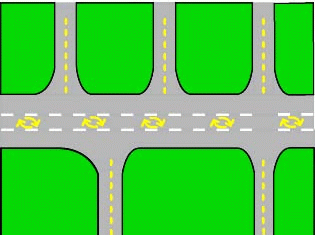Difference between revisions of "940.11 Three-Lane Cross-Sections"
m (article construction) |
m |
||
| (One intermediate revision by the same user not shown) | |||
| Line 1: | Line 1: | ||
| + | |||
| + | {|style="padding: 0.3em; margin-left:10px; border:2px solid #a9a9a9; text-align:center; font-size: 95%; background:#f5f5f5" width="180px" align="right" | ||
| + | |- | ||
| + | |'''Additional Information''' | ||
| + | |- | ||
| + | |[[940.10 Two-Way Left-Turn Lanes ("Five-Lane" Facilities)|EPG 940.10 Two-Way Left-Turn Lanes ("Five-Lane" Facilities)]] | ||
| + | |} | ||
| + | |||
Three-lane cross-sections (two through lanes with a TWLTL in the center) are approximately 25 percent safer than an undivided four-lane road and can provide comparable capacity provided that intersections are well designed. They work best in situations where traffic volumes are moderate and where the proportion of vehicles turning left is high. Discourage the use of TWLTLs in rural areas as their use in high speed, low volume situations can increase head-on crashes. Also, avoid them in urban areas where the design year traffic is expected to grow beyond 17,500 AADT. TWLTLs are best used with low to moderate driveway density (e.g., below 24 commercial driveways per mile equating to a spacing of about 440 ft. between driveways). | Three-lane cross-sections (two through lanes with a TWLTL in the center) are approximately 25 percent safer than an undivided four-lane road and can provide comparable capacity provided that intersections are well designed. They work best in situations where traffic volumes are moderate and where the proportion of vehicles turning left is high. Discourage the use of TWLTLs in rural areas as their use in high speed, low volume situations can increase head-on crashes. Also, avoid them in urban areas where the design year traffic is expected to grow beyond 17,500 AADT. TWLTLs are best used with low to moderate driveway density (e.g., below 24 commercial driveways per mile equating to a spacing of about 440 ft. between driveways). | ||
Latest revision as of 10:11, 4 December 2020
| Additional Information |
| EPG 940.10 Two-Way Left-Turn Lanes ("Five-Lane" Facilities) |
Three-lane cross-sections (two through lanes with a TWLTL in the center) are approximately 25 percent safer than an undivided four-lane road and can provide comparable capacity provided that intersections are well designed. They work best in situations where traffic volumes are moderate and where the proportion of vehicles turning left is high. Discourage the use of TWLTLs in rural areas as their use in high speed, low volume situations can increase head-on crashes. Also, avoid them in urban areas where the design year traffic is expected to grow beyond 17,500 AADT. TWLTLs are best used with low to moderate driveway density (e.g., below 24 commercial driveways per mile equating to a spacing of about 440 ft. between driveways).
This guideline does not refer to third lanes used as passing, turning or climbing lanes in rural areas.
| Roadway Classification | In Current and Projected Urban Areas | In Rural Areas |
|---|---|---|
| Major, Freeway | Not applicable | Not applicable |
| Major, Non-Freeway | May be used when appropriate when AADT in design year is less than 17,500 | Not recommended |
| Minor | May be used when appropriate when AADT in design year is less than 17,500 | Not recommended |
